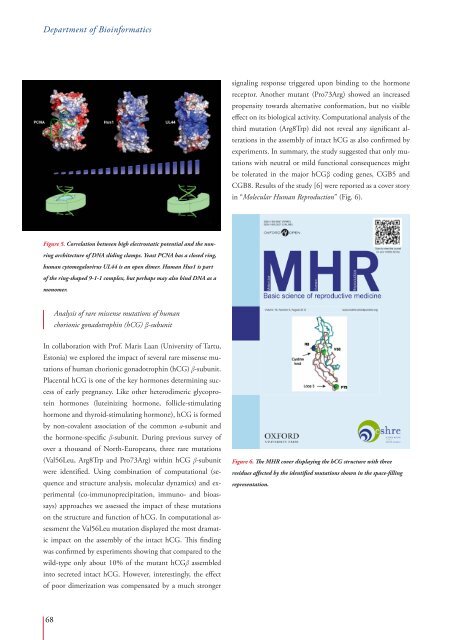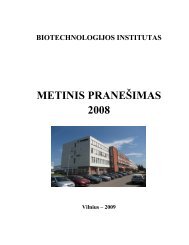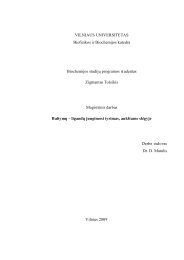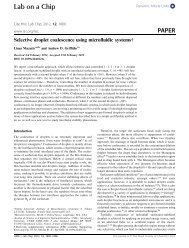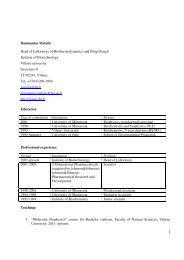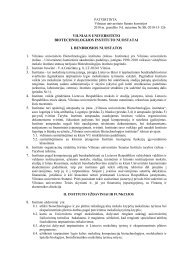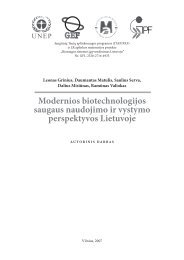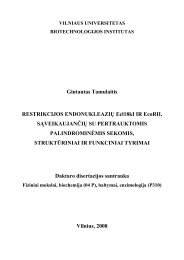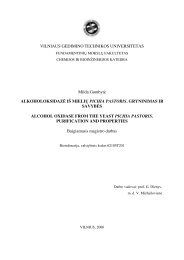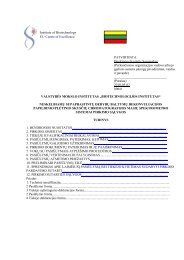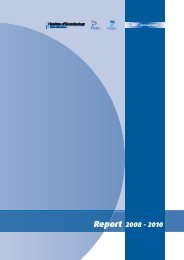Biennial Report 2011â2012
Biennial Report 2011â2012
Biennial Report 2011â2012
Create successful ePaper yourself
Turn your PDF publications into a flip-book with our unique Google optimized e-Paper software.
Department of Bioinformatics<br />
signaling response triggered upon binding to the hormone<br />
receptor. Another mutant (Pro73Arg) showed an increased<br />
propensity towards alternative conformation, but no visible<br />
effect on its biological activity. Computational analysis of the<br />
third mutation (Arg8Trp) did not reveal any significant alterations<br />
in the assembly of intact hCG as also confirmed by<br />
experiments. In summary, the study suggested that only mutations<br />
with neutral or mild functional consequences might<br />
be tolerated in the major hCGβ coding genes, CGB5 and<br />
CGB8. Results of the study [6] were reported as a cover story<br />
in “Molecular Human Reproduction” (Fig. 6).<br />
Figure 5. Correlation between high electrostatic potential and the nonring<br />
architecture of DNA sliding clamps. Yeast PCNA has a closed ring,<br />
human cytomegalovirus UL44 is an open dimer. Human Hus1 is part<br />
of the ring-shaped 9-1-1 complex, but perhaps may also bind DNA as a<br />
monomer.<br />
Analysis of rare missense mutations of human<br />
chorionic gonadotrophin (hCG) β-subunit<br />
In collaboration with Prof. Maris Laan (University of Tartu,<br />
Estonia) we explored the impact of several rare missense mutations<br />
of human chorionic gonadotrophin (hCG) β-subunit.<br />
Placental hCG is one of the key hormones determining success<br />
of early pregnancy. Like other heterodimeric glycoprotein<br />
hormones (luteinizing hormone, follicle-stimulating<br />
hormone and thyroid-stimulating hormone), hCG is formed<br />
by non-covalent association of the common α-subunit and<br />
the hormone-specific β-subunit. During previous survey of<br />
over a thousand of North-Europeans, three rare mutations<br />
(Val56Leu, Arg8Trp and Pro73Arg) within hCG β-subunit<br />
were identified. Using combination of computational (sequence<br />
and structure analysis, molecular dynamics) and experimental<br />
(co-immunoprecipitation, immuno- and bioassays)<br />
approaches we assessed the impact of these mutations<br />
on the structure and function of hCG. In computational assessment<br />
the Val56Leu mutation displayed the most dramatic<br />
impact on the assembly of the intact hCG. This finding<br />
was confirmed by experiments showing that compared to the<br />
wild-type only about 10% of the mutant hCGβ assembled<br />
into secreted intact hCG. However, interestingly, the effect<br />
of poor dimerization was compensated by a much stronger<br />
Figure 6. The MHR cover displaying the hCG structure with three<br />
residues affected by the identified mutations shown in the space-filling<br />
representation.<br />
68


